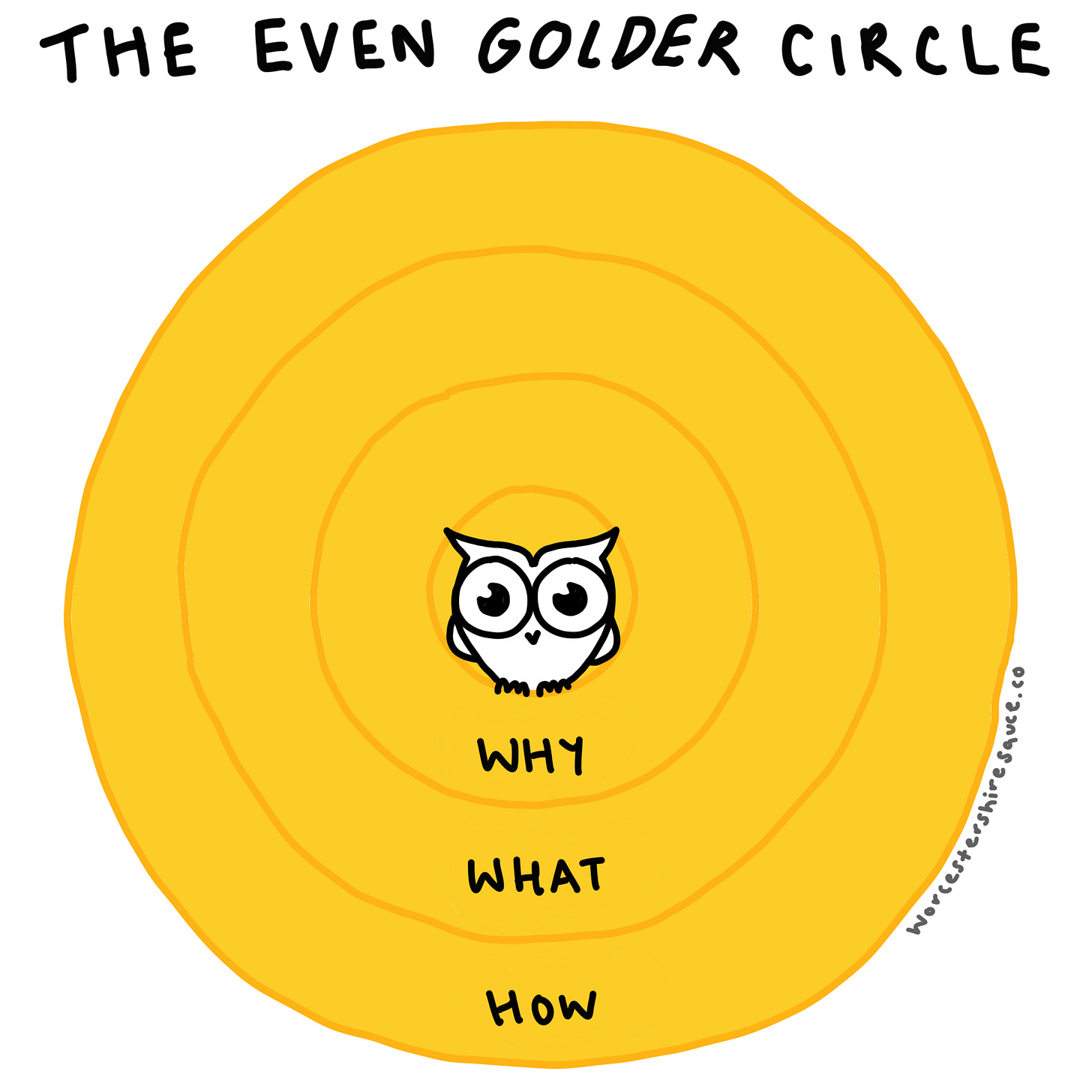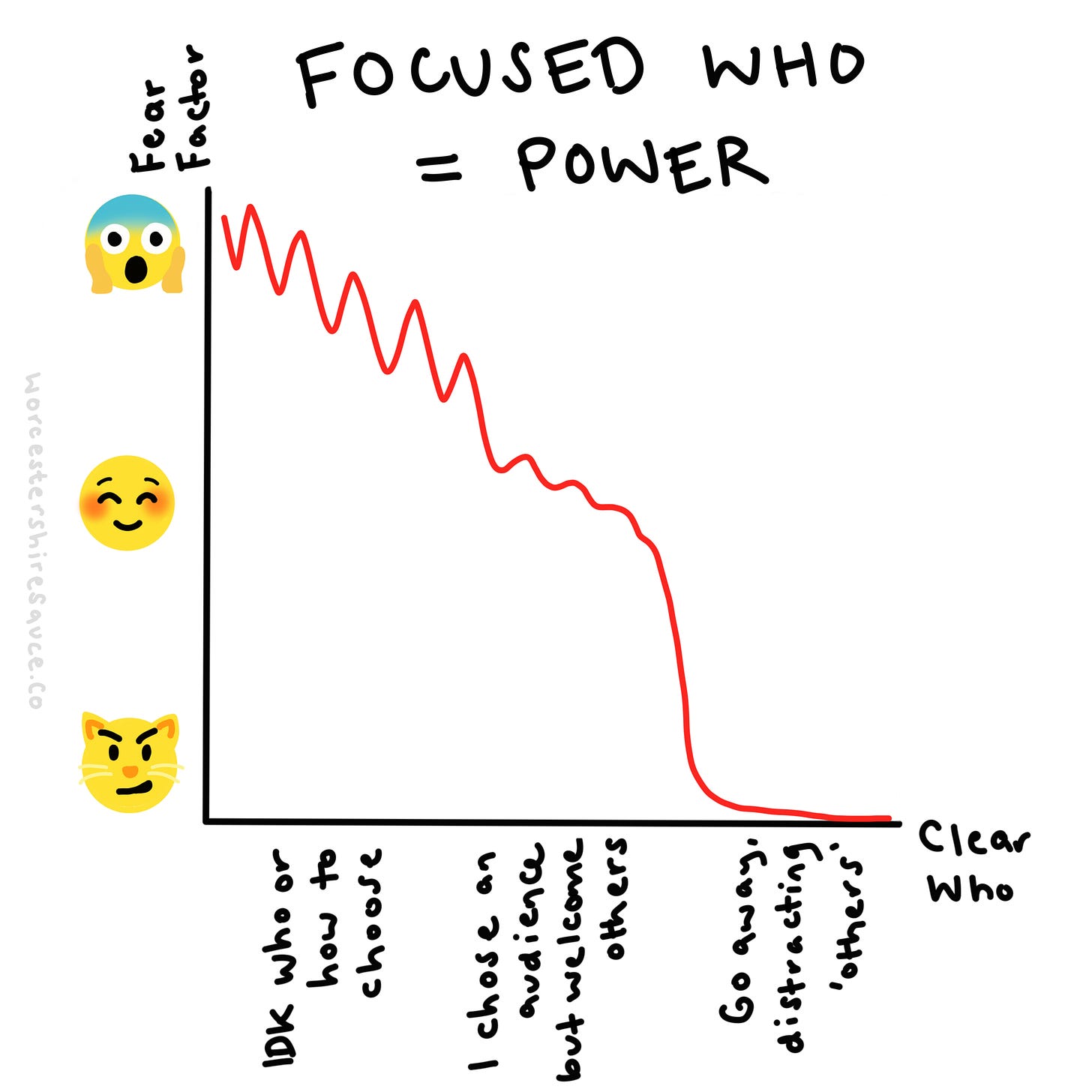Vent begins:
Founders and marketers are using Simon Sinek’s “Start With Why” as a catchphrase for everything. And it’s fine for company culture, or to guide the hiring process or whatever.
But the “why” logic gets taken out of context at every strategy meeting and people don’t attack it with sticks as they should.
Here’s the thang…
Don’t apply it to your product development or marketing decisions just cos “Simon says” makes you feel better.
Instead, start with who.
Here, I’ve made you an Even Golder Circle than Simon’s to help you remember: with product development and all things marketing… always start with HOO.
Cheesy? I couldn’t give a cracker.
HOO stands for
wHo’s
Our
Ordience.
Oh hush I’ll acronym and spell how I please; call the police.
We must wrench you from the grasp of the Why-For-Everything cult. We’ve got to cement images of owls and the word “who” in your brain.
Try this order:
Who are you serving?
Why do they need help/what problem are they solving, goal are they trying to achieve, or job are they trying to do?
What are (or should be) the solutions/products (or marketing activities)?
How is/should yours be different/special?
Is HOO really the be-and-end owl?
It’s a lot easier to come up with upsells, cross-sells, and marketing campaigns for someone who is already loyal to you and trusts that you understand their challenges.
Whereas it takes a lot of resources to start breaking your business up to serve everyone.
A zillion audiences will have you making cheap macaroni cheese in the same kitchen you prepare Ceviche garnished with Caviar, cos “oUr WhY iS tO mEeT hUnGeR WiTh TaStE sO wE sHoULd FeEd EvErYoNe, By OfFeRiNg A rAnGe Of TaStEs”.
Sorry but who exactly wants to go to that restaurant? Or work there? Kitchen from Hades.
So, pick an audience that you will serve and let that dictate your decisions.
In order to grow and scale, emerging brands have to focus. Too diverse a range of offers spread their systems thin, forcing them to carry random inventory, scattering their efforts across too many advertising platforms, and changing the lead gen process for each customer... and it means they don’t become known for doing a particular thing well.
They're everywhere, overwhelmed, and special to nobody.
Having a clear idea of HOO has real-life impact:
You build one set of people to conduct research on, becoming a pro about their problems/goals instead of having to learn from scratch with every new product launch.
Build your ad creative thinking about who you want to say “oh this was made for me” when they see it = instant trust
Keep your leads qualified and your pipes clear of any hairballs by stating your HOO on websites and social media profiles: “we help [who] to achieve/solve [their why]”
Launching offers that complement your hero product means you already have a warm audience that cares about solving the problem/symptoms of the problem. Think of women continually pouring money into their wrinkles and constantly adding more solutions!
Word of mouth. Customers and your wider network know exactly who to refer to your brand when they hear someone whine about the problem you solve — even if they’ve never used the solution themselves. People store specific info in their brains much better than vague generalities.
You’ll be leading about their problem/goal in all your marketing assets, instead of benefits, or (gasp) FEATURES. This is so powerful. It meets the customer bang in the middle of their selfish priorities. It’s not about you anymore. And they like, know, and trust faster as a result.
Make sense? Starting with HOO will turn you into the trusted brand for those people and clear so much confusion out of decision-making.
But… whom?
Where we trip up with audiences is the choosing bit. How to choose who ya gonna serve? You can’t even pick an ice cream flavour!?!?!?
Here are 2 simple approaches.
Pick your audience BEFORE you invent the solution: Make content, ask people their problems, and have them test product prototypes. You’ll build trust and whatever you launch after that will fly off the shelves. Like what is happening with YouTuber Mark Rober, who makes fun engineering videos, and recently launched a subscription box for kids to encourage them into STEM. This is a really natural way for founders to launch, cos they’re finding gaps around things they’re already interested in.
Build your solution, but just the basic version of it, and start having conversations with people in different groups: Do not skip the unsexy and laborious task of having convos with real people. Then, create campaigns for one group at a time, learning and narrowing in as you go. You won’t pick them… they’ll pick you. It will become clear that you have a bunch of people with x problem/goal in common that luuurv your product. Find the thing they have in common. Voila, there is your HOO.
This is gonna make life SO MUCH EASIER. You’re not spreading yourself thin. You’re not another commodity. You can speak to their problems in fluent “customer language”, jumping ahead of competitors that aren’t as focused.
It also means you can focus on creating a range of products that diagnose, alleviate, or cure the same problem. Different solutions for different budgets, levels of awareness, or raving fan-ness.
BUT WAIT! Won’t this repel other types of customers who also want your thing? Well, those people came looking for a specific features and benefits, so will sell themselves. It’s really not as big of a worry as you think.
That doesn’t mean you can’t branch out into more segments.
But focus on building one audience at a time — you may have enough growth without adding more — and with each product or marketing decision you make, frame it through the lens of “but whose problem am I trying to solve”.
Know that there is a pattern to this, and then trust the process to speed it up.
Your fear of choosing an audience will turn into confidence as you commit to focusing on HOO.
You have a lot of fear as you’re debating HOO and niches and all that. But then you narrow in a little, and you’re feeling better, happily serving your key peeps but appreciating the bonus sales from anyone outside of that.
And then you get to a point where those bonus people are holding you back from scaling, cos they break your systems and flow. So… you let them go. In fact, you sorta push them out. You focus harder on your core people so others are polarised by you. The fear is gone, and you’re growing faster and more easily, no longer weighed down by extra baggage.
You don’t need to spend a week around a board-room table stuffing your mouth with peppermints and stale coffee, creating personas. Customer Personas in the typical sense are making you focus on entirely the wrong thing.
It’s at this point “why” becomes useful again. “Why do they need help?” instead of imagining their hair colour, income, household status, or star sign…
What is the goal your audience is trying to accomplish, the problem they’re trying to rid of, or the job they need done? Thinking about that will have more real-world use than creating an AI image of your “ideal customer” and trying to imagine their daily routine.
Owl share more on that later.
Meantime, print and frame the Even Golder Circle for quick indoctrination. Make nocturnal bird noises in your next strategy meeting. Share this to LinkedIn to offend people in the Always-Why-Starters religion.
Oh and hey — don’t make Start With Hoo the next misused catchphrase!
Maybe there are other areas to apply it, but I intentionally specified marketing and product development decisions, cos that’s where I’ve personally used it.
Tu-whit tu-whoo,
Berna.
P.S. if you use Shopify and run FB/IG ads, a DTC agency I’m working with is creating a new tool that audits your ads lightning-fast. Reply to get on the list for free 90-day BETA access — enough time to transform your sales and then some?!


